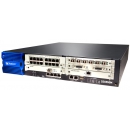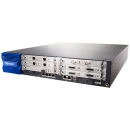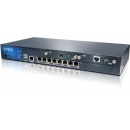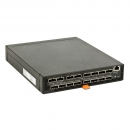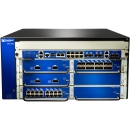Характеристики
Додаткова інформація:
Маршрутизатор Cisco 1721 забезпечує комплексне рішення VPN-доступу для малих і середніх офісів. Шасі містить два слота для модулів розширення. Від
моделі Cisco 1720 маршрутизатор Cisco 1721 відрізняється більшим
об'ємом вбудованої flash-пам'яті (32 мегабайт, проти 8 у попередній
моделі).
Маршрутизатор Cisco 1721 поєднує в собі наступні компоненти:
* - Один 10/100 Fast Ethernet порт;
* - Два слота для інтерфейсів глобальної мережі (WAN);
* - Один запасний (AUX) порт (послідовний асинхронний зі швидкістю до 115,2 Кбіт / сек);
* - Один консольний порт;
* - RISC процесор для високо - продуктивного кріптографірованія;
*
- Один внутрішній слот розширення для підтримки майбутніх сервісів на
апаратній основі, таких як кріптографірованіе (до Т1/Е1) і компресія.
The Cisco 1721 supports
standards-based IEEE 802.1Q VLAN routing, which enables enterprises to
set up multiple VLANs and route between them for added security within
the internal corporate network. Powered by Cisco IOS®
Software, the Cisco 1721 router provides a cost-effective solution for
small and medium businesses and enterprise small branch offices to
support e-business applications through a comprehensive feature set in
a compact design. The Cisco 1721 router offers the following key features: The Cisco 1700 Series supports the value of end-to-end Cisco network solutions with the following benefits: The Cisco 1721 router is
part of the end-to-end Cisco VPN solution. VPNs create secure
connections via the Internet to connect geographically dispersed
offices, business partners, and remote users while providing security,
traffic prioritization, management, and reliability equal to that of
private networks. By supporting industry
standards, IPSec, Layer 2 Tunneling Protocol (L2TP), and DES and 3DES,
the Cisco 1721 router delivers robust VPN solutions to ensure data
privacy, integrity, and authenticity. The optional VPN hardware
encryption module for the Cisco 1721 router further optimizes VPN
encryption performance. By offloading encryption tasks to the VPN
module, the router processor is freed to handle other operations. The
VPN module accelerates the rate at which encryption occurs, speeding
the process of transmitting secure data, a critical factor when using
3DES encryption. The Cisco 1721 router offers
integrated security features, including stateful inspection firewall
functionality and IDS as an optional Cisco IOS Software feature. By
deploying Cisco IOS Software firewall functionality, customers do not
need to purchase or manage multiple devices, thus simplifying network
management and reducing capital costs. Additionally, remote management
applications, such as Cisco Security Device Manager (SDM), make it
easier than ever to deploy and monitor Cisco IOS Firewall and VPN on
your Cisco 1721 router. Cisco IOS Software firewall
security features include access control lists (ACLs), user
Authentication, Authorization, and Accounting (such as Password
Authentication Protocol/Challenge Handshake Authentication Protocol
[PAP/CHAP], TACACS+, and Remote Access Dial-In User Service [RADIUS]).
These security features provide the optimal level of firewall
protection to customers. The Cisco 1700 Series
routers support the Cisco Easy VPN Remote feature that allows the
routers to act as remote VPN clients. As such, these devices can
receive predefined security policies from the headquarters' VPN
head-end, thus minimizing configuration of VPN parameters at the remote
locations. This solution makes deploying VPN simpler for remote offices
with little IT support or for large deployments where it is impractical
to individually configure multiple remote devices. While customers
wishing to deploy and manage site-to-site VPN would benefit from Cisco
Easy VPN Remote because of its simplification of VPN deployment and
management, managed VPN service providers and enterprises who must
deploy and manage numerous remote sites and branch offices with
Cisco IOS routers for VPN will realize the greatest benefit. The Cisco 1700 Series
routers also support the Cisco Easy VPN Server feature that allows a
Cisco 1700 router to act as a VPN head-end device. In site-to-site VPN
environments, the Cisco 1700 router can terminate VPN tunnels initiated
by the remote office routers using the Cisco Easy VPN Remote. Security
policies can be pushed down to the remote office routers from the Cisco
1700 router. In addition to terminating site-to-site VPNs, a Cisco 1700
router running the Unified VPN Access Server can terminate remote
access VPNs initiated by mobile and remote workers running Cisco VPN
client software on PCs. This flexibility makes it possible for mobile
and remote workers, such as sales people on the road, to access company
intranet where critical data and applications exist. The Cisco 1721 router supports business-class DSL through the optional ADSL or G.shdsl WICs. The Cisco 1721
business-class DSL solution combines the cost benefits of DSL service
with the advanced routing capability required for business use of the
Internet. Through enhanced DSL QoS features, performance levels for
mission-critical applications are guaranteed. (See Figure 2.) When equipped with optional
Ethernet WICs, the Cisco 1700 Series supports a two- or three-Ethernet
configuration, enabling deployment with an external broadband modem
(such as DSL, cable modem, or wireless modem)—often supplied by a
service provider as a demarcation point and deployment of a
demilitarized zone (DMZ). (See Figure 3.) The Cisco 1721 offers a
broad set of features designed to allow businesses to attain maximum
benefits on their investment and to easily deploy e-business solutions.
See Table 2 for key features and benefits. Table 1 Cisco 1721 Key Features and Benefits The Cisco 1721 supports up
to two of the WICs listed in Table 3. These WICs support a wide variety
of WAN technologies: Integrated Services Digital Network (ISDN),
asynchronous serial and synchronous serial such as leased lines, Frame
Relay, ADSL, G.shdsl, Switched 56, X.25, and Switched Multimegabit Data
Service (SMDS), and single-port Ethernet. Also available are WICs that
integrate a DSU/CSU into the Cisco 1721, eliminating the support costs
and complexity of deploying and managing external devices. Table 2 WAN Support for the Cisco 1721 Two-port low-speed serial (up to 128 kbps), asynchronous and synchronous All Cisco 1700 models are
equipped with an internal expansion slot to support an optional
field-installable hardware VPN encryption module. The VPN encryption
module offloads encryption processing from the Cisco 1700 Series RISC
processor, providing performance up to T1/E1 speeds. The VPN encryption
module (MOD1700-VPN) supports a maximum of 100 remote access tunnels. Cisco 1721 routers support a
full range of Cisco IOS features, including multiprotocol routing, QoS,
VPN, firewall/IDS, and legacy IBM protocol and applications in use
today. The Cisco 1721 router is
shipped with the base Cisco IOS feature sets supporting IP routing and
standards such as Network Address Translation (NAT), Open Shortest Path
First (OSPF), RADIUS, Remote Monitoring (RMON), VLAN routing, basic QoS
feature (Weighted Fair Queing), and Next Hop Resolution Protocol
[NHRP]). Cisco IOS IP Plus feature
sets contain L2TP, L2F, Border Gateway Protocol (BGP), IP multicast,
Frame Relay switched virtual circuit (SVC), RSVP, PPP over Ethernet
client, NetFlow, the Netware Link Services Protocol (NLSP), Simple
Multicast Routing Protocol (SMRP), the Web Cache Control Protocol
(WCCP), and the Network Timing Protocol (NTP). In addition, enhanced
QoS features are also supported (LLQ, FRTS, RSVP, CEF, WRED, DiffServ,
MLPP with LFI). IPSec encryption is offered
in special encryption feature sets (Plus IPSec 56 and Plus IPSec 3DES).
To build an IP VPN, the recommended feature sets are IP/Firewall Plus
IPSec 56 or IP/Firewall Plus IPSec 3DES. For a detailed list of features and memory requirements for a given feature set, see Cisco IOS 1700 Release Notes. The Cisco 1721 router supports a range of network-management and ease-of-installation tools. Cisco Security Device Manager (SDM) is
an intuitive, easy to use, web-based device management tool embedded
within the Cisco IOS access routers. SDM enables resellers and
customers to quickly and easily deploy, configure and monitor a Cisco
access router without requiring knowledge of Cisco IOS Command Line
Interface (CLI). Through smart wizards, SDM can automate best practices
for NAT, ACLs, VPN and firewall deployment. Other common LAN, WAN, and
routing protocol configurations can also be easily performed through
SDM. Network resellers and customers can further fine-tune router
configurations for changing business needs and preview the Cisco IOS
CLI for each configuration through SDM. CiscoWorks2000,
the industry-leading Web-based network management suite, provides the
ability to remotely configure, administer, monitor, and troubleshoot
the Cisco 1721 router; and increased visibility into network behavior
to quickly identify performance bottlenecks and long-term performance
trends. It also provides sophisticated configuration tools to optimize
bandwidth and utilization across expensive and critical WAN links in
the network. CiscoView,
part of CiscoWorks2000, is a Web-based tool that graphically provides
real-time status of the Cisco 1721 router. It can drill down to display
monitoring information on interfaces and provide dynamic status,
statistics, and comprehensive configuration information. CiscoWorks Small Network Management Solution (SNMS)
is a comprehensive, Web-based network management solution that provides
a powerful set of monitoring, configuration, and management tools to
simplify the administration of small to medium business networks and
workgroups that contain up to 20 Cisco internetworking products
(switches, routers, hubs, and access servers). CiscoWorks SNMS is an
ideal solution for companies that need server monitoring and network
management from a single application to optimize performance and
maximize network productivity. With CiscoWorks SNMS, Cisco provides a
cost-effective and user-friendly solution that helps Cisco customers
make the optimal use of their resources. The solution provides the
following: Cisco ConfigMaker
is a Microsoft Windows wizard-based tool designed to configure a small
network of Cisco routers, switches, hubs, and other network devices
from a single PC. This tool makes it easy to configure value-add
security features such as the Cisco IOS Firewall Feature Set, IPSec
encryption, NAT, the Dynamic Host Configuration Protocol (DHCP) server,
and to establish VPN policies (including QoS and security). The Cisco 1700 Series
enables deployment of a cost-effective, seamless network infrastructure
for small and medium-sized businesses and small enterprise branch
offices. The Cisco 1700 Series access routers include the Cisco 1710,
1721,1751, 1760 (offered as a base model), Cisco 1751-V and Cisco
1760-V (offered as a multiservice-ready model.) The Cisco 1751 and Cisco
1760 Modular Access Routers are optimized for multiservice data and
voice solutions. The Cisco 1721 router is a modular device optimized
for data-access applications. The Cisco 1710 Security Access Router
features comprehensive security with VPNs, Cisco IOS Firewall, and
advanced routing functionality in an all-in-one device. Technical Support Services
for the Cisco 1721 are available through Cisco SMARTnet and SMARTnet
Onsite service programs. Cisco SMARTnet support augments the resources
of your operations staff; it provides them access to a wealth of
expertise, both on line and via telephone, the ability to refresh their
system software at will, and a range of hardware Advance Replacement
options. Cisco SMARTnet Onsite
provides all SMARTnet services and complements the hardware
Advance-Replacement feature by adding the services of a field engineer,
offering support that can be critical for those locations where
staffing is insufficient or unavailable to perform parts-replacement
activities. Table 4 gives features and benefits of Cisco SMARTnet
support. Table 3 Cisco SMARTnet Features and Benefits Technical Support Services Cisco SMARTnet support is
available to customers from both Cisco directly and through Cisco
channel partners. Partners purchasing direct from Cisco may offer Cisco
Branded Resale of Cisco SMARTnet Software. Partners purchasing through
distribution may offer Packaged Cisco SMARTnet Software. For partners supporting the
Cisco 1721 with their own service and support infrastructure, System
Integrator Support 98 (SIS98) is available. The Cisco 1700 series,
including the Cisco 1721, is in compliance with the requirements of the
countries for distribution. The Cisco 1700 Series conforms to Safety,
EMI, Immunity, and Network homologation standards. Details can be
obtained through your Cisco reseller or account manager.
There are special terms applicable to your hardware warranty and
various services that you can use during the warranty period. Your
formal Warranty Statement, including the warranties and license
agreements applicable to Cisco software, is available on Cisco.com.
Follow these steps to access and download the Cisco Information Packet and your warranty and license agreements from Cisco.com.
1.
http://www.cisco.com/univercd/cc/td/doc/es_inpck/cetrans.htm
The Warranties and License Agreements page appears.
2.
a.
b.
c.
The Cisco Limited Warranty and Software License page from the Information Packet appears.
d.
Note
3.
a.
78-10747-01C0
b.
c.
The Cisco warranty page appears.
d.
You can also contact the Cisco service and support website for assistance:
http://www.cisco.com/public/Support_root.shtml.
Duration of Hardware Warranty
One (1) Year
Replacement, Repair, or Refund Policy for Hardware
Cisco or its service center will use commercially reasonable efforts to
ship a replacement part within ten (10) working days after receipt of a
Return Materials Authorization (RMA) request. Actual delivery times can
vary, depending on the customer location.
Cisco reserves the right to refund the purchase price as its exclusive warranty remedy.
To Receive a Return Materials Authorization (RMA) Number
Contact the company from
whom you purchased the product. If you purchased the product directly
from Cisco, contact your Cisco Sales and Service Representative.
Complete the information below, and keep it for reference.
Company product purchased from
Company telephone number
Product model number
Product serial number
Maintenance contract number
This document describes the steps for installing your Cisco 1721 router with its complement of WAN interface cards (WICs).
Additional documentation can be found on Cisco.com.
The serial number label for Cisco 1721 router is located on the rear of the chassis, to the right of the power switch.
Your router package should include the following items:
•
•
•
•
•
•
Depending on your network environment, you may need to provide some of the following items to install the router:
•
•
•
•
•
Follow these steps to connect the router to the power supply:
Step 1
Figure 1 Connecting the Power Supply
Step 2
Step 3
Step 4
Step 5 You need to provide
straight-through Ethernet cables for connecting the router to the local
Ethernet network. For more information on these cables, refer to the
"Cabling Specifications" chapter in the hardware installation guide
that came with the router. Follow these steps to connect the router to
your local network:
Step 1 The Cisco 1721 Modular Access Router is
designed to help organizations embrace the productivity benefits of
e-business applications. The Cisco 1721 router enables e-business by
delivering secure Internet, intranet, and extranet access with virtual
private networks (VPNs) and firewall technology. The Cisco 1721 router
offers:
Figure 1:
The Cisco 1721 Router delivers a versatile e-business WAN access solution.

E-Business Applications
VPN and Security
Business-Class DSL
Figure 2
The Cisco 1700 Series Deployed with an ADSL WIC

Figure 3:
The Cisco 1700 Series Deployed with an Ethernet WIC and an External DSL or Cable Modem

Comprehensive Feature Set and Benefits
Hardware/Software Options
Comprehensive WAN Support
WIC
Description
Hardware VPN Encryption Module
Cisco IOS Software Feature Sets
Network Management and Installation Tools
Cisco 1700 Series
Service and Support
Technical Support Services
Features
Benefits
Cisco SMARTnet Support Cisco SMARTnet Onsite Support
Technical Support Services Delivery
Technical Specifications
Figure 4
Rear Panel, Cisco 1721 Access Router

Physical Interfaces/Ports
WAN Interface Specifications (Optional)
Link Access Procedure, Balanced (LAPB), IBM Systems Network Architecture (SNA) Dimensions and Weight
Power
Environmental
Safety
EMI
Immunity
Network Homologation
Cisco 1721 Router Cabling and Installation
1 Cisco One-Year Limited Hardware Warranty Terms
![]() Launch your browser, and go to this URL:
Launch your browser, and go to this URL:
![]() To read the Cisco Information Packet, follow these steps:
To read the Cisco Information Packet, follow these steps:
![]() Click the Information Packet Number field, and make sure that the part number 78-5235-03A0 is highlighted.
Click the Information Packet Number field, and make sure that the part number 78-5235-03A0 is highlighted.
![]() Select the language in which you would like to read the document.
Select the language in which you would like to read the document.
![]() Click Go.
Click Go.
![]() Read the document online, or click the PDF icon to download and print the document in Adobe Portable Document Format (PDF).
Read the document online, or click the PDF icon to download and print the document in Adobe Portable Document Format (PDF).

![]() You must have Adobe Acrobat Reader to view and print PDF files. You can download the reader from Adobe's website: http://www.adobe.com
You must have Adobe Acrobat Reader to view and print PDF files. You can download the reader from Adobe's website: http://www.adobe.com
![]() To read translated and localized warranty information about your product, follow these steps:
To read translated and localized warranty information about your product, follow these steps:
![]() Enter this part number in the Warranty Document Number field:
Enter this part number in the Warranty Document Number field:
![]() Select the language in which you would like to view the document.
Select the language in which you would like to view the document.
![]() Click Go.
Click Go.
![]() Read the document online, or click the PDF icon to download and print the document in Adobe Portable Document Format (PDF).
Read the document online, or click the PDF icon to download and print the document in Adobe Portable Document Format (PDF).
2 Overview
Product Serial Number Location
3 Parts List
![]() One Cisco 1721 router
One Cisco 1721 router
![]() One blue RJ-45-to-DB-9 console cable
One blue RJ-45-to-DB-9 console cable
![]() One DB-9-to-DB-25 adapter
One DB-9-to-DB-25 adapter
![]() One black power supply
One black power supply
![]() One black power supply cord
One black power supply cord
![]() Product documentation
Product documentation
Items You Need to Provide
![]() Ethernet hub or switch to connect the router to the local network
Ethernet hub or switch to connect the router to the local network
![]() Straight-through
Ethernet cables (RJ-45-to-RJ-45) to connect the router to a broadband
(xDSL or cable) modem and to a hub or switch
Straight-through
Ethernet cables (RJ-45-to-RJ-45) to connect the router to a broadband
(xDSL or cable) modem and to a hub or switch
![]() Cisco WIC(s), if you did not order the router with WICs already installed
Cisco WIC(s), if you did not order the router with WICs already installed
![]() Cables to connect WICs to the appropriate WAN services
Cables to connect WICs to the appropriate WAN services
![]() External NT-1 or data service unit/channel service unit (DSU/CSU), if needed, to connect a WIC to WAN services
External NT-1 or data service unit/channel service unit (DSU/CSU), if needed, to connect a WIC to WAN services
4 Connect the Power Supply
![]() Connect the attached power supply cord to the power socket (labeled +5, +12, -12 VDC) on the back panel of the router, as shown in Figure 1.
Connect the attached power supply cord to the power socket (labeled +5, +12, -12 VDC) on the back panel of the router, as shown in Figure 1.
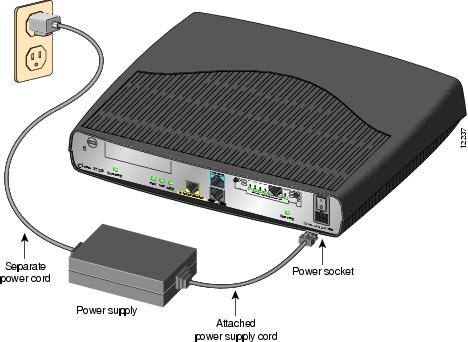
![]() Connect the separate power cord to the power socket on the power supply.
Connect the separate power cord to the power socket on the power supply.
![]() Connect the other end of the separate power cord to a power outlet.
Connect the other end of the separate power cord to a power outlet.
![]() Turn on the router by pressing the power switch to the on ( | ) position.
Turn on the router by pressing the power switch to the on ( | ) position.
![]() Confirm that the router has power by checking that the PWR LED on the front panel is on.
Confirm that the router has power by checking that the PWR LED on the front panel is on.
5 Connect the Router to Your Local Network
![]() Connect one end of an Ethernet cable to th
Connect one end of an Ethernet cable to th
Подібне
-
 NETGEAR ProSafe FS108P
NETGEAR ProSafe FS108P
6475.00 грн

